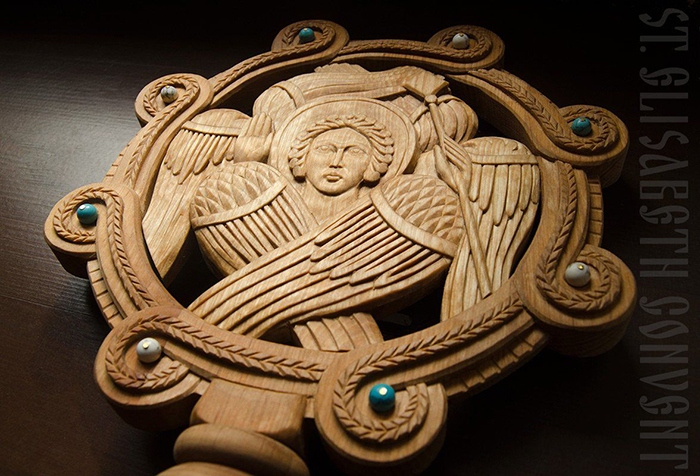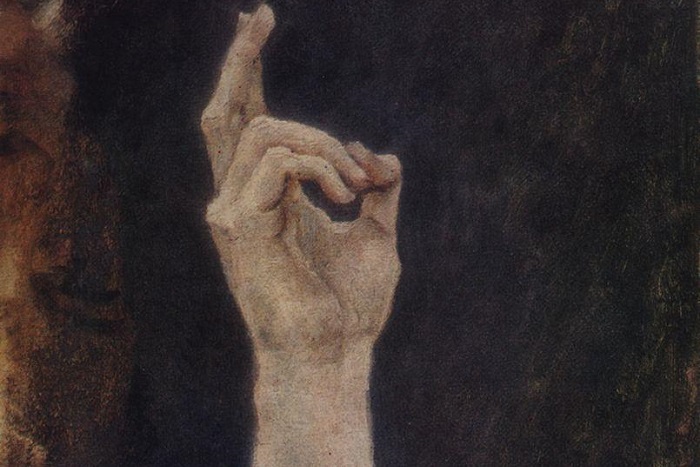
You can sometimes spot through the open Royal Door of Orthodox churches two shining discs on stakes next to the High Place. They are used quite seldom, except for particularly solemn and festive services. What is the purpose of these liturgical objects, when did they appear and what do they symbolize?
Practical Use
Liturgical fans (Greek. Ριπίδιον – fan) have been used by mankind for their intended purpose since time immemorial. The predecessors of these liturgical objects have been mentioned since the time of Ancient Egypt – fans were widely used at the court of pharaohs and in rich houses, producing air movement and protecting the dignified masters from insects and heat. Such artifacts were discovered in Tutankhamun’s grave during the excavations of the 20th century and date back to the 14th century BC. How and when the fans appeared in Christian worship is not known for sure, but it is a fact that they have been used since the early centuries of Christianity. The Apostolic Constitutions, a liturgical canonical document traditionally attributed to the second half of the 4th century, provide the first evidence of the use of fans in Christian worship: “Two deacons on either side of the Holy Table must hold fans made of thin leather or peacock feathers or canvas, and quietly drive away small flying creatures so that they do not fall into the chalice” (Book VIII, 12).

Thus, the fans initially had a purely practical function – to drive away insects from the Holy Gifts, which was especially relevant in countries with hot climates. They were known both in the East and West, where they were called flabella. Gradually they were differentiated between smaller ones – for waving over the Holy Gifts, and larger ones – for solemn processions. In the West, the liturgical use of flabella ceased by the 14th century, whereas in the East they received rich symbolic interpretations and have remained to this day.
Symbolism
The presence of peacock feathers on the fans, which persisted in the East until the 9th century, gradually led to the idea that the fans symbolize the incorporeal angelic powers who invisibly participate in the Sacraments of the Church. The special ornament in the shape of an eye on the feathers of the peacock reminded believers of the many-eyed Seraphim, who chant incessantly to God (See the Anaphora of St. John Chrysostom). It is likely that by the 7th century the images of the Seraphim began to appear on liturgical fans, although Christ with the Evangelists and the Deesis were also depicted. St. Photios († 891) writes that the deacons weave with fans made of feathers in the shape of six-winged Seraphim in order to distract the attention of believers from the material side of the Sacrament, so that they do not dwell on the visible, but move on to the invisible and untold beauty instead. Such use of liturgical fans, as we can see, acquired a didactic worship role. St. Symeon of Thessalonica († 1429) says that a deacon is entrusted with a fan at his ordination, because the deacon himself performs the ministry of Seraphim at the Liturgy and is endowed with angelic dignity, as evidenced by the numerous altar frescoes of angels in the form of young men holding liturgical fans.

Nowadays, deacons hardly use fans during worship services. Interestingly though, the current Orthodox Sluzhebnik still contains instructions to the deacon to reverently weave over the Holy Gifts with a fan during the Anaphora, both to chase away flies (cf. the instructions of the Sluzhebnik after the Great Entrance) and to symbolize the presence of heavenly hosts. Just as deacons drive away insects from the Holy Gifts, so the heavenly hosts drive away the spirits of darkness from the place where the greatest Sacrament is celebrated. However, according to St. John Chrysostom, the very Blood of the Lord is terrifying for demons, for “demons flee when they see the Blood of the Lord, and the angels gather” (Conversation 43 on the Gospel of John). It should be noted that fans are another link that connects the Christian Church with the Old Testament Tabernacle and the Temple, because there were images of the Cherubim sitting around the Ark of the Covenant in the Holy of Holies of the Tabernacle as well.
Present-Day Practice
At present, fans are used mainly in ordination of deacons as well as during some hierarchical divine services. According to the Typikon, they should be brought out during the Little and Great Entrances for the shadowing of the Gospel, the Diskos and the Chalice, respectively (Instructions for Pontifical Service). Fans are also used to honor locally revered icons, relics of saints, significant liturgical objects, such as the Shroud, during processions, and when a bishop is buried, they are held over the body of the deceased bishop. The use of these ancient objects is also allowed for a priestly Liturgy, which makes it possible to enrich any service and instill awe in the flock, emphasizing the holiness of what these fans overshadow and recall the presence of the Seraphim even in the poorest parishes.



